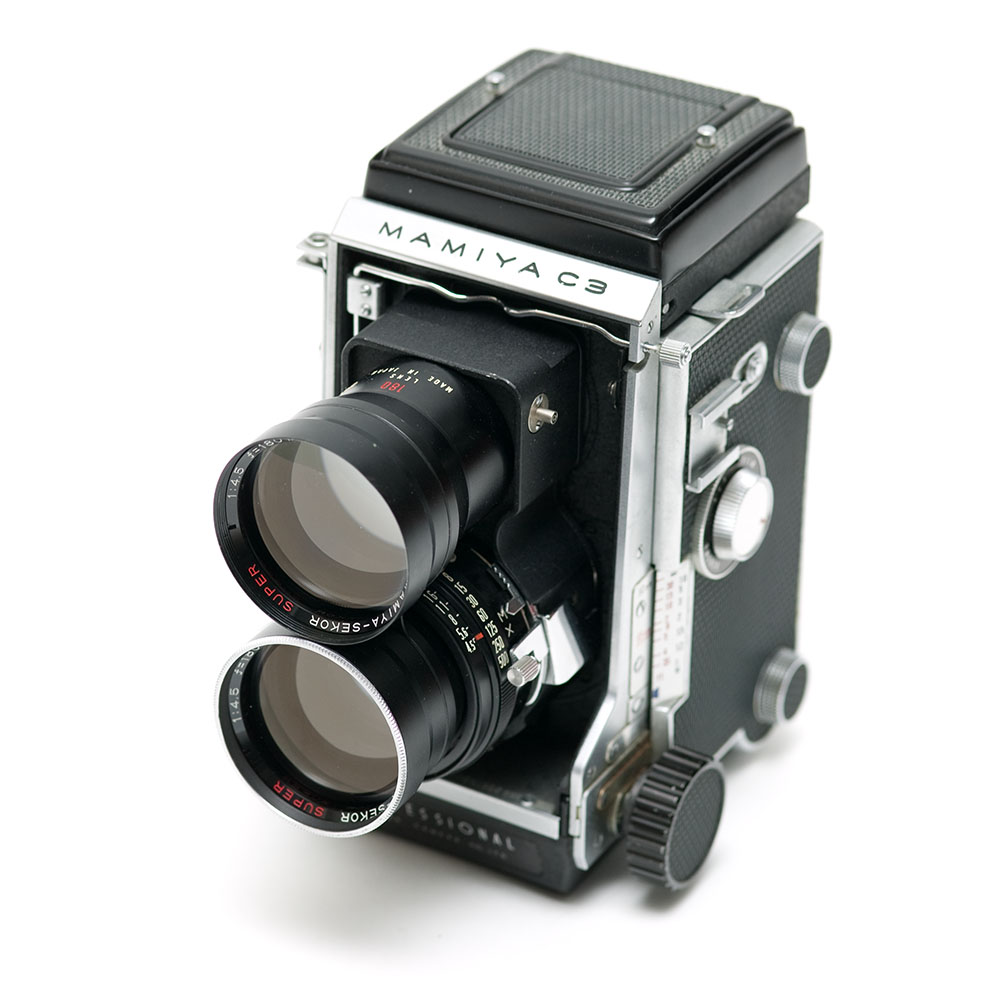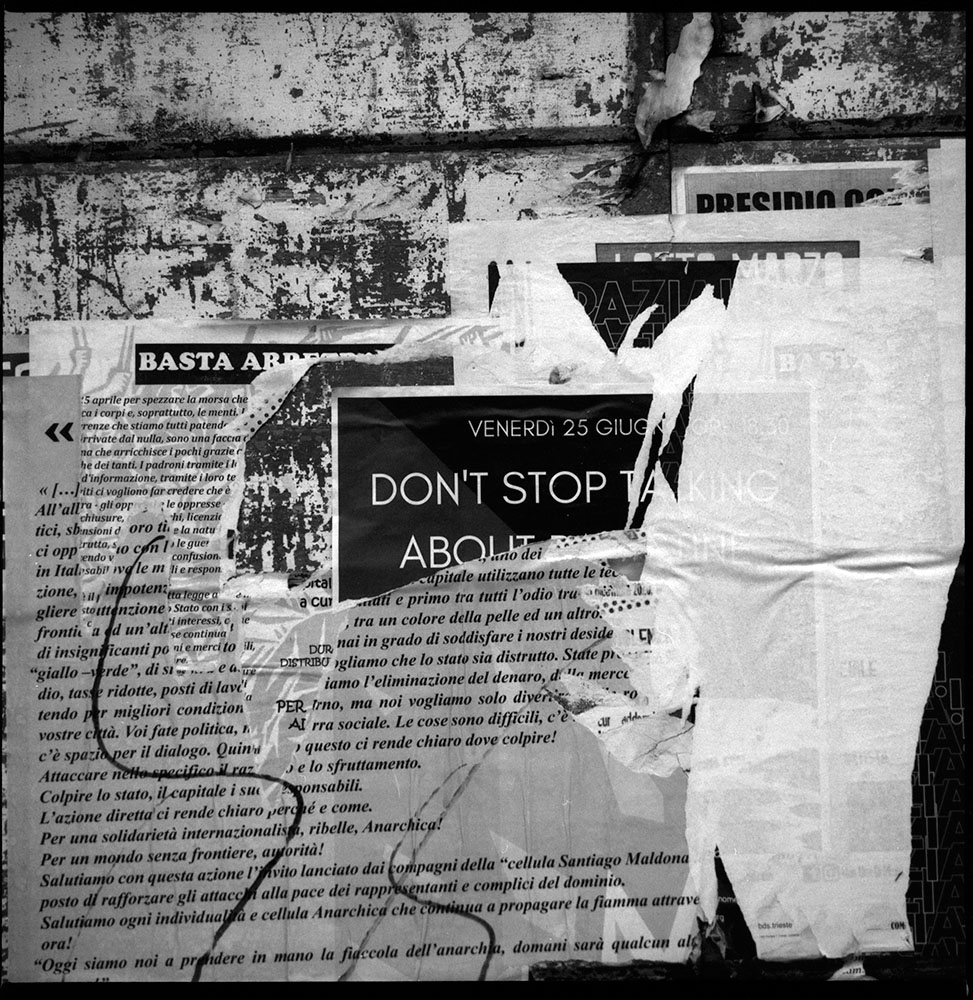Let's have a look at the Mamiya 180mm f/4.5 Super. It's a slightly long-ish lens for Mamiya's long-running TLR system. And it's super. Here's what it looks like:
The Mamiya TLR system is fascinating. As far as I know it didn't have a name, but nowadays people call it the C-System or C-Series because the cameras were all called C2, C3, C33, C330 etc.
Mamyai launched the system in the 1960s and continued to develop and sell it until the mid-1990s, by which time twin-lens reflex cameras were a massive anachronism. Nonetheless a handful of TLR designs remained in production because they had a niche. The YashicaMat and Seagull were cheap ways of trying out medium format, the Rolleiflex had an excellent lens and bags of class, the Lubitel was popular with hipsters.
The C-Series on the other hand was aimed at professional photographers who wanted to shoot 6x6cm medium format without the expense of a Hasselblad or Bronica. By the 1980s there were other options, such as Mamiya's own 6x7 and 645 cameras, but long before Instagram came along some people preferred 6x6 square.
For the shots in this blog post I used a Mamiya C3. I also have a C33, pictured above, but the winding mechanism is fussy, and I didn't want to risk it. As you can see from the picture the lenses come off as a single unit.
The C3 was discontinued in 1965, so my camera is over half a century old, and yet it still works and still appears to have some of the original grease. It's essentially a metal box with some simple gears and a bellows system, so there isn't much to go wrong. As of 2021 C-series cameras are still widely available on eBay, alongside the cheaper, simpler C2/C22/C220, which had a winding knob instead of a crank.
Is it my favourite camera? If my camera heart was a pie chart the Olympus XA and Pen F would have the largest slices, but the Mamiya C would be close behind. Medium format in general is great fun. Even if you have a cheap flatbed film scanner the negatives scan well, because they're so large. The surface area means that dust and scratches are less of a problem, and furthermore medium and larger formats have a certain "look".
The Look comes from a combination of low vignetting, good central sharpness, smooth tones, and clear background-foreground separation combined with a normal field of view. The best medium and larger format photography often reminds me of Disney's multi-plane camera system - I mentally imagine that the image is composed of layers of glass stacked on top of each other. It's the elusive "3D Pop" that people on the internet talk about.
The last C-series camera was the C330S, which was launched in the early 1980s. The range was discontinued about a decade later, apparently because the tooling used to manufacture the cameras was starting to wear out. My hunch is that if I had to use one professionally, as a job, I would quickly grow to hate the size, the difficulty of changing film, the difficulty of composing through a reversed viewfinder - TLR viewfinders mirror the image from left-to-right - plus the constant need to remind people to look at the bottom lens, the need to stand on a stepladder in order to capture people's faces straight-on instead of shooting up their nostrils, etc. But for casual use none of that matters.
Besides which this is 2021 and nostrils are sexy.
Does Mamiya still exist? The company surived into the digital age but was bought by Phase One in 2015. The website is dated 2019. It seems to be one of those entities, like Atari and Vivitar, that only exists in a legal sense. It's a nice name, it sounds happy.
The C-Series had a modest range of lenses. The widest was a 55mm f/4.5. I have one! I've written about it before. In 35mm terms it's a little bit like a 28mm, perhaps a bit narrower. The longest was a 250mm f/4.5, which is a little bit like a 135mm lens for a 35mm camera. There were no third-party Mamiya TLR lenses, no special effect lenses - no fisheye, no soft focus - and the fastest was the standard 80mm f/2.8. They all had clockwork leaf shutters mounted inside the lens. The shutters are robust, and will synchronise with flash at all speeds, but after half a century they tend to gum up.
The speeds tended to range from 1/500 down to 1/s plus bulb. For almost all the shots on this page I stuck with 1/125th, occasionally 1/60th. Ordinarily it's bad form to use slow speeds with long lenses, but the C3 is heavy, and there's no mirror bounce - the shutter just goes PING - so luckily 1/60th was fast enough. The aperture closes down to f/45, forty-five, but I shot almost everything on this page wide open. It was November and I was using slow film.
The lenses are relatively easy to open and clean out, and the viewing and taking optics are almost always the same, so if one lens element is damaged it can be replaced by its twin. I was lucky to find a good 180mm on eBay so I haven't had to open mine up.
The original 180mm f/4.5 non-Super was part of the first batch of lenses. My C3 has a focus scale marked out for it on the bellows:
As you can see infinity focus requires racking out the bellows a little bit, which makes street photography with a 180mm f/4.5 even more awkward than it would be otherwise.
Also pictured is a stiffening ring, which screws into the 49mm filter thread. The filter threads are very thin, and given the weight of the camera it's easy to bash them. The stiffening ring is supposed to keep them safe. It's not a UV filter, it doesn't have any glass in it.
A big metal TLR is an odd choice for street photography. On the downside my C3 is heavy and hard to carry, and only takes twelve shots per roll, but on the upside I have the impression that most passers-by don't recognise a TLR as a camera - it's a boxy mechanical thing - and furthermore TLR focusing doesn't involve eye contact, so people don't perceive it as a threat.
A word about focal lengths. Focal lengths. Let's talk about focal lengths. I'm going to assume you're familiar with the idea of a crop factor. On a full-frame digital SLR or 35mm film camera a 180mm lens is a mild telephoto, a head-and-shoulders portrait lens. Not long enough for wildlife or sport. On a digital SLR with a smaller sensor however a 180mm acts almost like a 300mm lens, which is great for sports but still not long enough for wildlife, unless you're in a zoo.
Medium format on the other hand goes the other way. It has a reverse crop factor, because the 6x6cm negative is larger than the 36x24mm negative of 35mm film. To work out the 35mm equivalent of a medium format lens I always divide the focal length by two and add ten, so the 180mm f/4.5 acts a bit like a 100mm lens in 35mm terms.
Contemplate the following image, in which a sculpture of a man who has a pigeon on his head puts the finishing touches on a sculpture of a man while observed by another man (me) who is in turn sculpting a scene of a sculpture of a man with a pigeon on his head putting the finishing touches on a sculpture of a man:

























